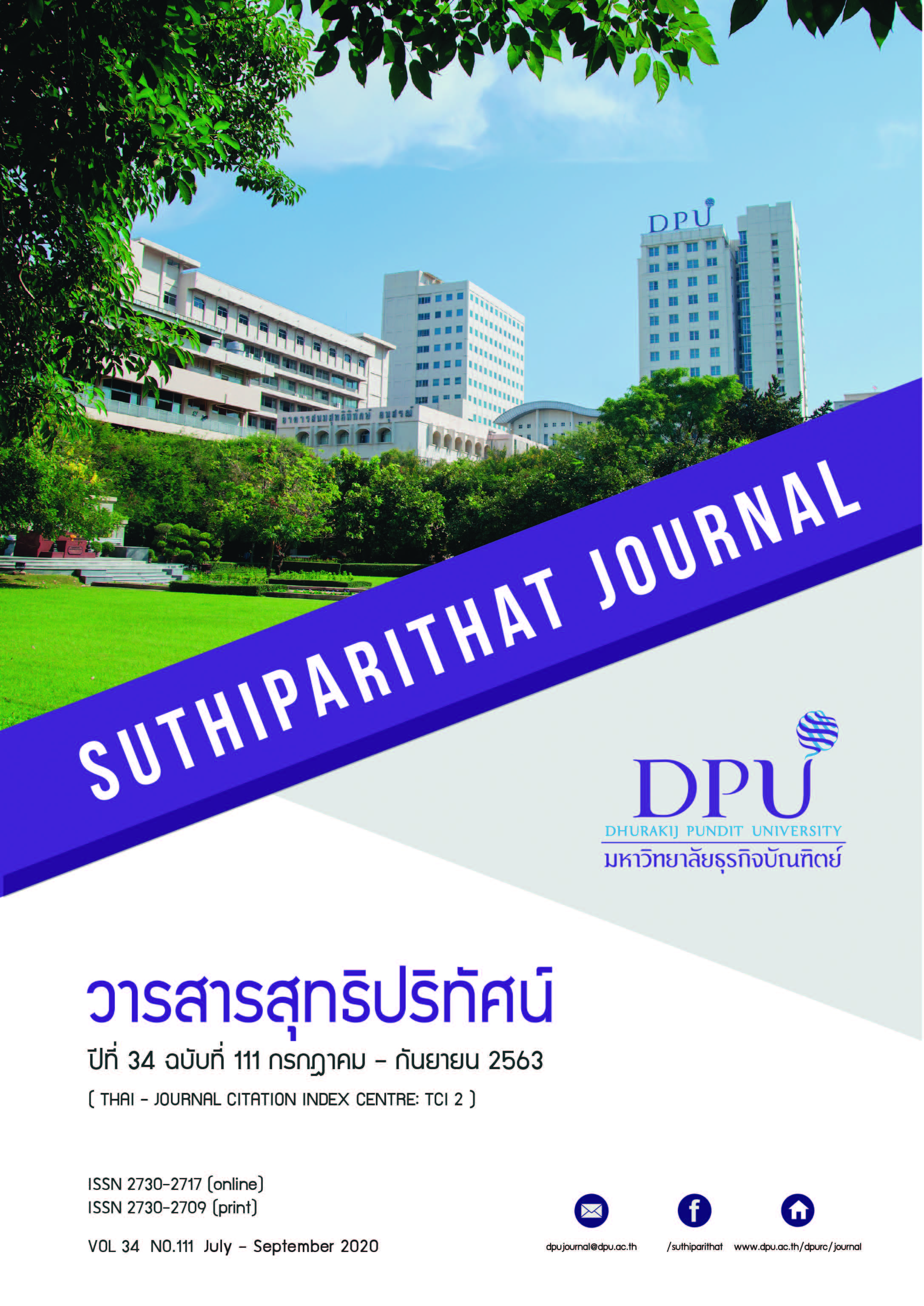The THE INFLUENCE OF ENTERPRISE RISK MANAGEMENT ON FIRM VALUE MEASURED BY TOBIN’S Q OF LISTED COMPANIES IN THE STOCK EXCHANGE OF THAILAND
Keywords:
Enterprise Risk Management, Firm Value, Structural Equation Modeling (SEM)Abstract
Enterprise risk management is an important factor that influences and affects the enterprise value of the organization. The standard of enterprise risk management based on COSO concepts divide enterprise risk management on 4 area which are Strategy, Operational, Financial and reporting and Compliance. In addition, there are internal factors within the organization that influence the firm value, the internal factors are Slack and Leverage. Therefore, this research aimed to study the influence Enterprise Risk Management on firm value measured by Tobin’s Q through internal operational factors of companies listed on the Stock Exchange of Thailand. The population used in this study was the companies listed on the Stock Exchange of Thailand. The specific sampling method was used to select only the companies in the SET100 Index continuously from 2015 – 2018, found a total of 61 companies, totaling 244 samples. Collect data used for statistical analysis from financial reports and annual reports. Research techniques used in this research were correlation coefficient analysis and structural equation techniques using path analysis methods. The result of research show the strategy, operational, financial and reporting and compliance with relevant regulations has direct effect on the firm value when operating factors within the organization regarding the financial risk of the business. The results of this research can use the relationship model from the study to consider and plan the risk management in the organization appropriately in order to create good business values in the future.
References
พรรณนุช ชัยปินชนะ, และณัฏฐ์ปาลิตา ศรีคาหน้อย. (2561). การจัดการความเสี่ยงของธุรกิจนำเที่ยวในจังหวัดเชียงใหม่. วารสารวิชาการสมาคมสถาบันอุดมศึกษาเอกชนแห่งประเทศไทยในพระราชูปถัมภ์ สมเด็จพระเทพรัตนราชสุดาฯ สยามบรมราชกุมาร ฉบับมนุษยศาสตร์และสังคมศาสตร์, 23(2), 46-55.
มนวิกา ผดุงสิทธิ์. (2548, เมษายน-มิถุนายน).การประเมินผลการปฏิบัติงานตามแนวคิด Tobin-Tobin’s Q. วารสารบริหารธุรกิจ คณะพาณิชยศาสตร์และการบัญชี มหาวิทยาลัยธรรมศาสตร์, 28(106), 13-22.
Ballantyne, R. (2013). An empirical investigation into the association between enterprise risk management and firm financial performance (Doctoral dissertation). Available from ProQuest Dissertations & Theses Global. (UMI No. 1335138343)
Beasley, M., Pagach, D., & Warr, R. (2008). Information conveyed in hiring announcements of senior executives overseeing enterprise-wide risk management processes. Journal of Accounting, Auditing, and Finance, 23(3), 311-332.
Brennan, N., & Solomon, J. (2008). Corporate governance, accountability and mechanisms of accountability: an overview. Accounting, Auditing & Accountability Journal, 21(7), 885-906.
Cendrowski, H., & Mair, W. C. (2009). Enterprise risk management and COSO: A guide for directors, executives and practitioners. New Jersey: John Wiley & Sons.
Christie, A. A., & Zimmerman, J. L. (1994). Efficient and opportunistic choices of accounting procedures: Corporate control contests. The Accounting Review, 69(4), 539-566.
Epps, R. W., & Cereola, S. J. (2008). Do Institutional Shareholder Services (ISS) Corporate governance ratings reflect a company operating performance. Critical Perspectives on Accounting, 19(8), 1135-1148.
Ghosh, Santana, & Mondal, Amitava. (2009). Indian software and pharmaceutical sector IC and financial performance. Journal of Intellectual Capital, 10(3), 369-388.
Healy, P. M., & Wahlen, J. M., (1999). A review of the earnings management literature and its implications for standard setting. Accounting horizons, 13(4), 365-383.
Kee H., Chung, & Pruitt, Stephen W. (1994). A simple approximation of Tobin’s Q. Financial Management, 23(3), 70-74. doi: 10.2307/3665623
Lawrence A. Gordon, Martin P. Loeb and Chih Yang Tseng. (2009). Enterprise risk management and firm performance: A contingency perspective. J. Account. Public Policy 28, 301 – 327.
Lindenberg, Eric B., & Ross, Stephen A. (1981). Tobin’s Q Ratio and industrial organization. Journal of Business, 54(1), 1-32.
McShane, M., Nair, A., & Rustambekov, E. (2011). Does enterprise risk management increase firm value. Journal of Accounting, Auditing and Finance, 26(4), 641-658.
Mitra, S., & Karathanasopoulos, A. (2019). Firm value and the impact of operational management. Asia-Pacific Financial Markets, 26, 61–85.
O’Keefe, T. B., King, R. D., & Gaver, K. M. (1994). Audit fees, industry specialization, and compliance with GAAS reporting standards. Auditing, 13(2), 41–55.
Pagach, D., & Warr, R. (2010). The effects of enterprise risk management on firm performance. Available from http://dx.doi.org/10.2139/ssrn.1155218
Smith, C. W., & Stulz, R. M. (1985, December). The determinants of firms’ hedging policies. Journal of Financial and Quantitative Analysis, 20(4), 391-405.
Soileau, J. S. (2010, July). Enterprise risk management: adoption, performance benefits and disclosure effects (Doctoral dissertation) The University of Memphis.
The Committee of Sponsoring of the Treadway Commission (COSO). (2017). Enterprise risk management-integrating with strategy and performance. N.P.: Author.
Downloads
Published
How to Cite
Issue
Section
License
Content and information of the article published at Suthiparithat Journal are based on the sole opinions and responsibility of author(s) only. Neither the editorial board involve in......







